Cats
What Causes Cats Ears to Feel Hot?
Get insights into why cats' ears feel hot, from heat regulation to allergies and ear conditions, to ensure your feline's well-being.
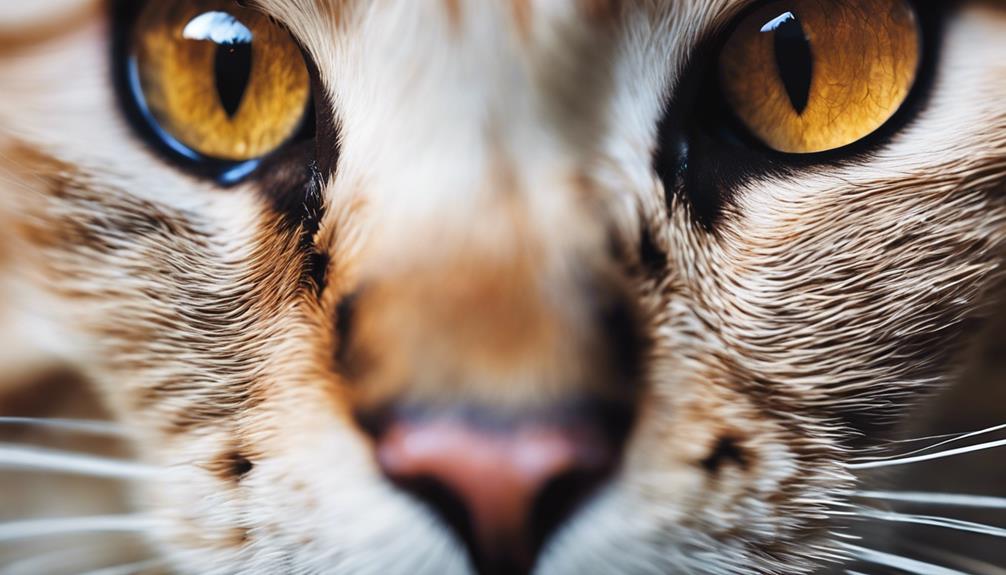
Cats' ears can feel hot as they regulate body temperature by increasing blood flow. This warmth often indicates a response to heat, allergies, fever, or ear conditions. Cats naturally manage hot weather by increasing blood flow to their ears, paws, and nose, helping release excess heat. Allergic reactions, fever, and specific ear issues can also lead to warm ears in cats. Monitoring your feline's well-being is important, especially if accompanied by unusual symptoms. Understanding these causes can help you better care for your pet's health and comfort. Further insights into cat ear conditions and temperature management are essential for responsible pet ownership.
Key Takeaways
- Cats regulate body temperature by increasing blood flow to ears.
- Warm ears indicate a response to excess heat.
- Monitoring ear warmth can reflect overall well-being.
- Hot ears in cats are common in hot weather.
- Consult a vet if hot ears are accompanied by unusual symptoms.
Normal Ear Temperature Regulation
When cats regulate their body temperature, they increase blood flow to their ears. This clever mechanism helps our feline friends release excess heat, especially during warmer days. So, if you've ever felt your cat's ears and noticed they were a bit warm, don't worry – it's a normal response to temperature changes. Those toasty ears are actually a sign that your cat's body is working hard to stay cool and comfortable.
Monitoring your cat's ears for warmth is a good way to keep an eye on their overall well-being. Warm ears are usually nothing to be concerned about, but if you notice other unusual symptoms along with the warmth, it might be a good idea to consult with your vet. By paying attention to these little cues, we can help our cats stay healthy and happy, even when they're trying to beat the heat with their adorable, warm ears.
Cats Response to Hot Weather

When the weather gets hot, cats have some clever ways to stay cool.
They increase blood flow to their ears, paws, and nose, allowing them to release excess heat.
Cats Heat Regulation
Cats efficiently regulate their body temperature by increasing blood flow to their ears, nose, and paws in response to hot weather. When you notice your kitty's ears feeling warm, it's their way of releasing excess heat and preventing overheating. Those toasty ears are a natural response to keep their body temperature in check.
To help your feline friend stay cool during hot weather, provide shade, plenty of water, and lend a hand with grooming. By ensuring these simple measures, you can assist your cat in managing the heat and keeping their ears at a comfortable temperature.
Sun Exposure Effects
In scorching weather, feline companions respond to sun exposure by utilizing their ears, paws, and nose to regulate body temperature efficiently. When cats are exposed to the sun's rays, their ears may feel warm as increased blood flow helps release excess heat from their bodies. This natural response aids in cooling them down during hot weather. Providing shade, water, and grooming assistance can further assist cats in managing their body temperature. Here is a helpful table to understand how cats respond to sun exposure:
| Response | Description |
|---|---|
| Warm Ears | Increased blood flow aids in heat release |
| Paws and Nose | Also involved in regulating body heat |
| Grooming Assistance | Helps cats cool down and maintain comfort |
Behavior in Heat
Responding to high temperatures, feline companions exhibit distinct behaviors to cope with the heat and regulate their body temperature efficiently. Cats regulate their body temperature by increasing blood flow to their ears, paws, and nose when the weather gets hot. This increased blood flow helps them release excess heat, and you might notice their ears feeling warm. It's a vital response to aid in cooling their bodies.
To help your cat stay cool and prevent overheating during hot weather, provide shade, plenty of water, and grooming assistance. Monitoring your cat's behavior is essential, as extreme heat can be dangerous for them. By understanding their cooling mechanisms and taking proper care, you can make sure your furry friend stays comfortable even in the hottest weather.
Allergic Reactions and Hot Ears
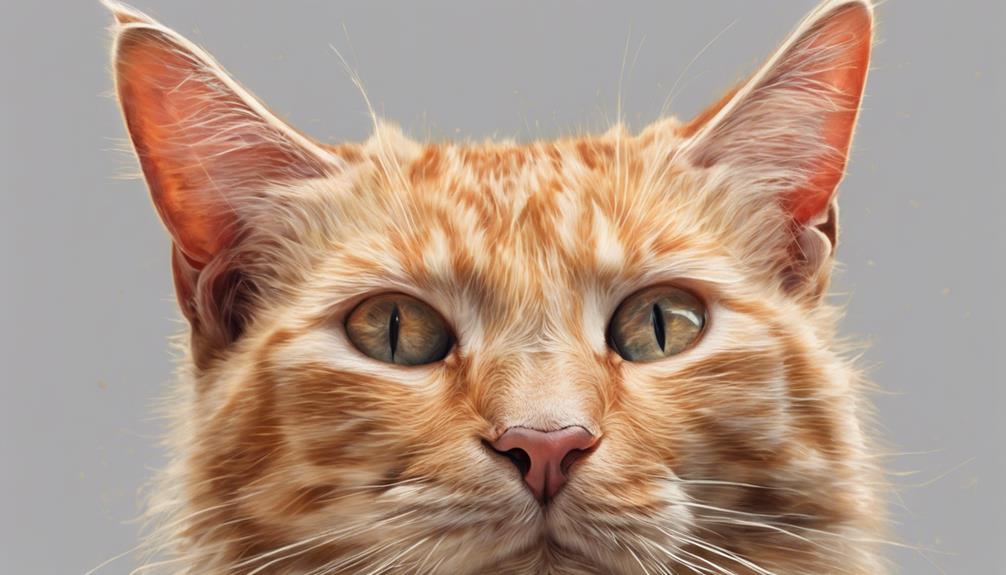
Experiencing allergic reactions can often result in cats having hot ears as a noticeable symptom. When our furry friends come into contact with allergens like pollen or grass, their immune system can react, leading to symptoms such as bloating, sneezing, and those telltale hot ears. If you notice your cat's ears feeling warm, it could be a sign of an allergic reaction. Fortunately, allergy testing can pinpoint the specific allergen triggering this response, helping us find effective solutions for managing hot ears in cats.
To provide clarity on allergic reactions and hot ears in cats, here is a helpful table outlining key points:
| Topic | Description | Importance |
|---|---|---|
| Allergens | Pollen, grass, insects, certain foods | Identifying triggers |
| Symptoms | Bloating, sneezing, hot ears | Indicating allergies |
| Allergy Testing | Pinpoint specific allergen causing hot ears | Tailored treatment |
Understanding these aspects can assist in addressing allergic reactions and keeping our feline companions comfortable and healthy.
Fever Indications in Cats

After discussing how hot ears in cats can be a sign of allergic reactions, we now shift our focus to identifying fever indications in felines. Fever in cats is often accompanied by a range of symptoms that can help you recognize when your furry friend might be feeling under the weather. Signs of fever include lethargy, reduced appetite, and behavioral changes.
If you suspect your cat might've a fever, it's crucial to check their temperature. Using a rectal thermometer is the most accurate way to measure a cat's temperature, as their ears feeling warm alone may not provide an accurate reading. Remember, a cat's normal temperature ranges from 101° to 102.5°F.
If your cat's temperature is persistently above 104°F, seek immediate veterinary care to address any underlying issues. Keeping an eye out for these indications and promptly seeking veterinary attention when needed can help guarantee your cat stays healthy and happy.
Troublesome Ear Mites

Ear mites, tiny parasites that cause intense itching and discomfort in cats, can be a troublesome issue for feline health. These pesky parasites not only irritate your furry friend but can also lead to more severe problems if left untreated.
Here are some key points to keep in mind about ear mites:
- Symptoms: Look out for dark discharge resembling coffee grounds in your cat's ears, indicating a possible ear mite infestation.
- Medication: It's important to consult a vet for proper medication to effectively treat ear mites and provide relief to your cat.
- Contagious: Ear mites are highly infectious and can easily spread to other pets or even to you if not managed promptly.
- Treatment: Prompt intervention is essential to prevent the infestation from worsening and causing discomfort to your beloved pet.
Potential Ear Infections
Ear infections in cats can cause their ears to feel warm to the touch. Signs of an infection may include redness, discharge, or a foul odor.
Treatment options typically involve medications prescribed by a veterinarian.
Signs of Infection
Frequent scratching or pawing at a cat's ears may be an indication of discomfort or pain associated with a potential ear infection. When observing your feline friend, keep an eye out for these signs of infection:
- Redness in the ear canal
- Swelling around the ear area
- Foul odor emanating from the ears
- Discharge, crustiness, or black debris inside the ears
If you notice any of these symptoms, it's crucial to seek immediate veterinary attention for your cat. Ear infections can lead to further complications like head shaking, tilting, and hearing loss if left untreated. By addressing these signs promptly, you can make certain your cat receives the necessary care to alleviate their discomfort and prevent potential complications.
Treatment Options
Upon diagnosing a potential ear infection in cats, various treatment options are available to address the underlying causes and alleviate discomfort. Seeking prompt veterinary attention is essential to guarantee the correct treatment plan for your feline companion. Treatment for ear infections may involve the use of antibiotics to combat bacterial infections, antifungal medications for yeast-related issues, or gentle ear cleaning to remove debris and excess wax. Ignoring ear infections can lead to serious complications, such as hearing loss in cats, underscoring the importance of timely intervention. Below is a table summarizing the common treatment options for ear infections in cats:
| Treatment Options | Description |
|---|---|
| Antibiotics | Combat bacterial infections in the ear canal |
| Antifungal Medications | Treat yeast-related ear infections |
| Ear Cleaning | Remove debris and excess wax from the ear canal |
Understanding Cats Body Temperature

Understanding how cats regulate their body temperature is crucial for their overall health and well-being. Cats have a higher normal body temperature range of 101° to 102.5°F compared to typical human body temperature. When you feel warm cat ears, it's because blood flow increases to help release excess heat. This natural mechanism is essential for keeping your feline friend comfortable and healthy.
Cats have a higher normal body temperature range of 101° to 102.5°F compared to humans.
Feeling slightly warm ears in cats is normal due to their elevated body temperature.
Cats' ears help regulate body temperature by increasing blood flow to ears, paws, and nose.
Warm ears in cats during hot weather is a natural response to help release excess heat.
Understanding these aspects of your cat's body temperature can help you better care for them and make sure they stay happy and healthy.
Identifying Fever in Cats
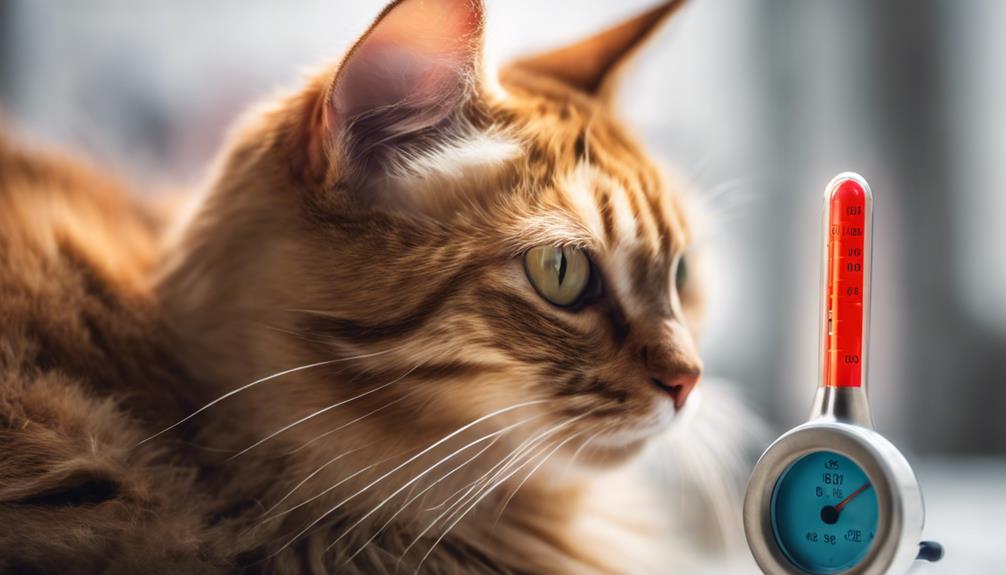
False
Signs of Elevated Temperature
Spotting signs of elevated temperature, such as lethargy and loss of appetite, can help identify fever in cats. When observing your feline friend, look out for these key indicators:
- Lethargy: If your cat is unusually tired or less active than usual, it could be a sign of fever.
- Loss of Appetite: Refusing food or eating noticeably less might indicate an elevated temperature.
- Shivering: Trembling or shivering, especially if accompanied by other symptoms, could be a sign of a fever.
- Checking Body Warmth: Feel the stomach and underarms for unusual warmth, which might suggest a fever.
Monitoring Body Temperature
To accurately monitor a cat's body temperature and identify fever, feeling the ears for warmth can be a valuable indicator. A cat's normal body temperature typically falls between 101° to 102.5°F.
Hot ears in cats may signal a fever, especially when coupled with behavioral changes, lethargy, or reduced appetite. While warm ears alone don't definitively confirm a fever, they can prompt further investigation.
Using a rectal thermometer is the most precise method to check a cat's temperature, with anything above 103°F considered important. If you suspect your feline friend has a fever, it's essential to seek prompt veterinary care.
Your vet can provide guidance on monitoring body temperature and managing fevers in cats effectively.
Dealing With Allergies in Cats
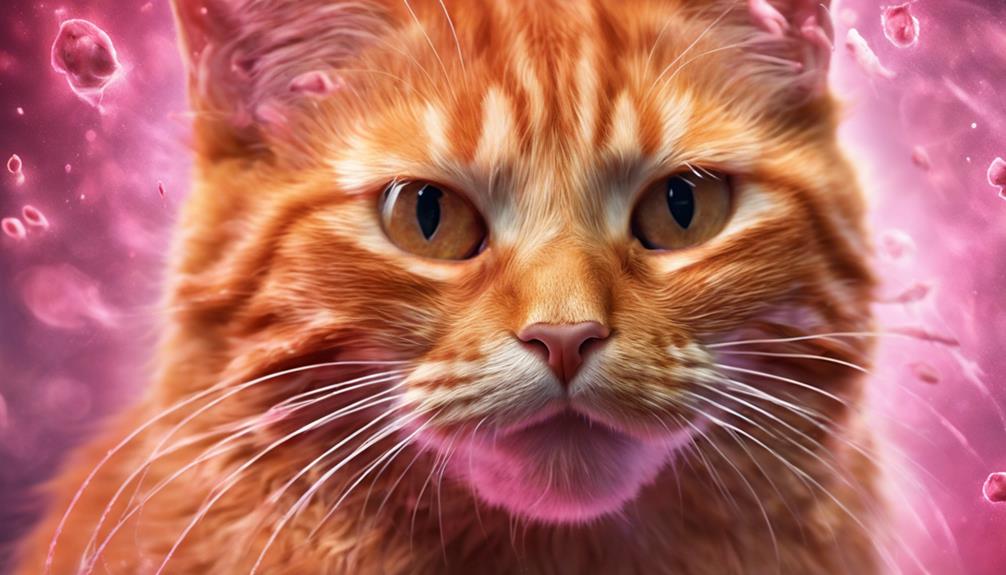
Dealing with allergies in cats requires identifying and addressing the specific irritants that trigger allergic reactions in feline companions. Allergies in cats can be caused by various irritants like pollen, grass, insects, and certain foods. When your cat shows symptoms such as sneezing, wheezing, watery eyes, or excessive licking, it's important to take into account the possibility of allergies. Seeking veterinary care for allergy testing is necessary to pinpoint the exact allergen affecting your cat.
Once the allergen is identified, managing and treating allergic reactions can be done effectively. Here are some strategies for dealing with allergies in cats:
- Consider using antihistamines to alleviate symptoms.
- Allergy shots can help desensitize your cat to specific allergens.
- Making dietary changes may reduce allergic reactions.
- Regular veterinary care and monitoring are essential to guarantee your cat's health and well-being.
Addressing Ear Mite Infestations
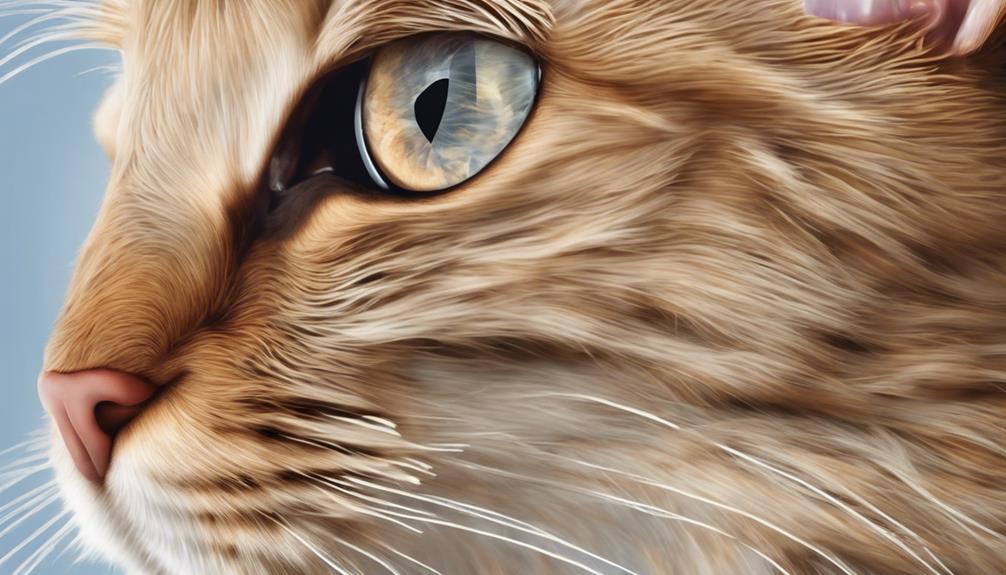
When addressing ear mite infestations in cats, it's essential to identify the symptoms, such as excessive scratching and dark discharge in the ears.
Treatment for ear mites typically involves medication prescribed by a veterinarian, and regular cleaning is vital for preventing further issues.
Identifying Ear Mites
Identifying ear mites in cats involves closely examining the ear canal for dark discharge resembling coffee grounds. When dealing with ear mites, it's vital to pay attention to the following signs:
- Presence of dark discharge in the ear canal
- Itching and discomfort exhibited by the cat
- Inflammation and heat in the ears
- Potential for secondary infections if left untreated
If you notice these symptoms, it's important to seek prompt attention from a veterinarian. Professional treatment is necessary to effectively eliminate ear mites and prevent further discomfort for your feline friend. Remember, addressing ear mite infestations promptly can help safeguard your cat's ear health and overall well-being.
Treating Ear Mite Infections
To effectively address ear mite infestations in cats, prompt veterinary intervention with proper medication is vital. When a cat has hot ears or if you notice dirty, highly contagious ear mites, seeking medical help promptly is imperative. Ear mites can spread quickly, causing discomfort and potential ear infections.
Over-the-counter treatments may not be effective against these pesky parasites. A veterinarian will be able to diagnose the issue accurately and prescribe the appropriate medication to treat the infestation. Remember, ear mites are highly contagious, so it's crucial to address the problem promptly to prevent it from spreading to other pets or even to humans.
Managing Cat Ear Infections

One essential aspect in caring for cats is effectively managing ear infections caused by bacteria, yeast, or ear mites.
When dealing with cat ear infections, it's important to take into account the following:
- Symptoms: Keep an eye out for signs like pain, head shaking, and altered balance, which could indicate an ear infection.
- Complications: Untreated infections can lead to serious issues, including hearing loss, so immediate attention is vital.
- Veterinary Attention: Seeking immediate help from a vet is essential for accurate diagnosis and appropriate treatment.
- Treatment: Treatment options may include antibiotics, antifungal medications, and regular ear cleaning to address the infection.
Cats Natural Temperature Control

Cats naturally regulate their body temperature by increasing blood flow to their ears, paws, and nose. When you notice your cat's ears feeling warm, it's often a sign of this natural temperature control mechanism at work. Increased blood flow to the ears helps your feline friend release excess heat, especially when the environmental temperature changes.
Those cute, warm ears aren't just adorable but also crucial for your cat's well-being. The veins in their ears expand when it's warm to allow heat to escape and constrict when it's cold to maintain heat within the body. By understanding how cats use their ears to manage body temperature, you can guarantee they stay comfortable and healthy.
Signs of Fever in Cats
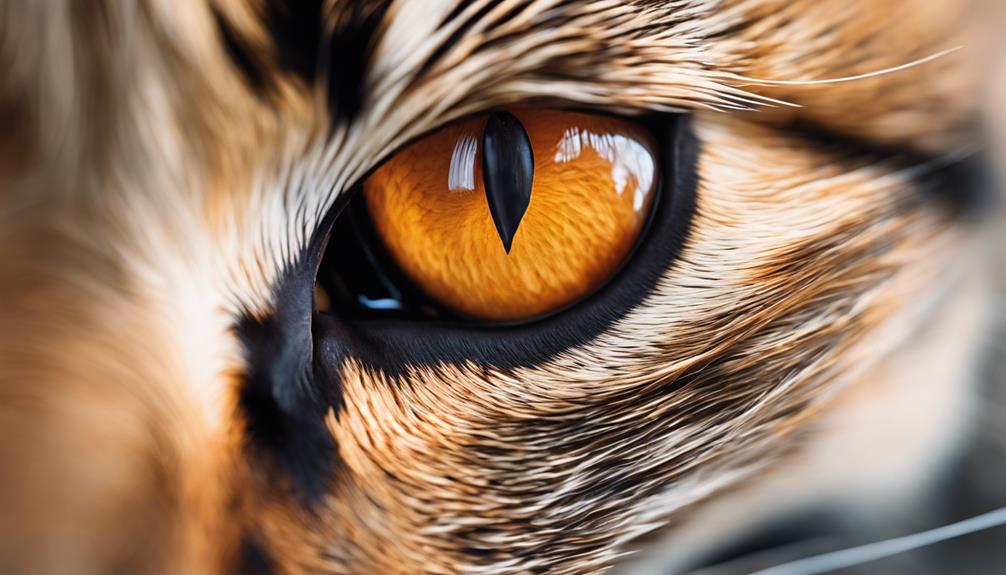
When a cat's body temperature rises above 103.5°F, it indicates the presence of a fever. Signs of fever in cats may include:
- Lethargy, where your feline friend seems unusually tired and less active than usual.
- Loss of appetite, as cats with fevers often show a decrease in their interest in food.
- Shivering, where your cat may tremble or shake involuntarily in response to the increased body temperature.
- Using a rectal thermometer is the most accurate way to check your cat's temperature and confirm the presence of a fever.
If your cat's fever persists above 104°F, it's important to seek immediate veterinary attention. Additionally, isolating behavior and a change in appetite can also be indicators of fever in cats.
Monitoring your cat's body temperature and being attentive to these signs can help you detect a fever early and make sure your furry companion receives the necessary care promptly.
Coping With Allergies in Cats

To address allergies in cats, understanding common triggers like pollen, grass, insects, and certain foods is vital for effective management. Cats with allergies may exhibit symptoms such as bloating, sneezing, wheezing, watery eyes, and hot ears.
If you notice your feline friend excessively licking their ears, it could be a sign of allergies affecting them. It's important to consult a veterinarian for allergy testing to pinpoint the specific irritants causing reactions in your cat.
By identifying the allergens, you can then explore effective solutions like antihistamines to help manage your cat's allergies and provide them with relief. Remember, each cat may react differently to various allergens, so tailored approaches based on allergy testing results are key to finding the best way to cope with your cat's allergies.
Remedies for Ear Mite Problems
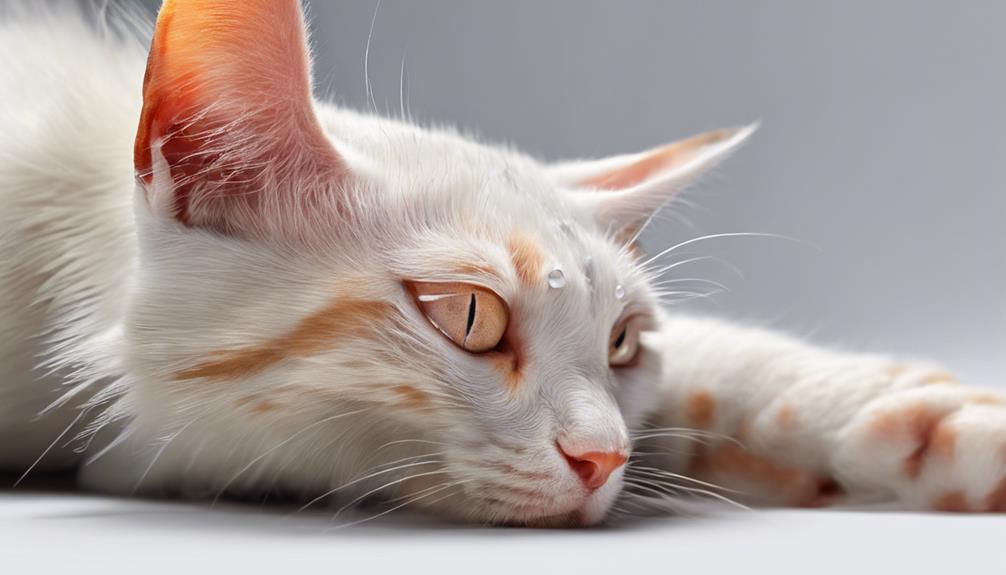
Upon noticing symptoms of ear mite infestation in your pet, seeking proper medication from a vet is essential for effective treatment. Ear mites are tiny parasites that cause intense itching and discomfort in cats. Symptoms of ear mite infestation include dark discharge resembling coffee grounds in the ears. If left untreated, ear mites can spread to other pets and even humans, highlighting the importance of prompt intervention.
While over-the-counter remedies may be available, they may not provide adequate treatment for ear mites in cats.
- Seek proper medication from a vet for effective treatment.
- Watch out for symptoms like dark discharge in the ears.
- Remember that ear mites can spread to other pets and humans if left untreated.
- Be cautious with over-the-counter remedies, as they may not offer sufficient relief for ear mite problems in cats.
Taking swift action and following the vet's advice can help alleviate your cat's discomfort and prevent the spread of ear mites.
Frequently Asked Questions
Should I Be Worried if My Cats Ears Are Hot?
If our cats' ears feel hot without other concerning signs, it might not be worrisome. Still, we suggest monitoring. Hot ears can be normal for temperature regulation. But if in doubt, consulting a vet is wise.
What Are the Symptoms of Fever in Cats?
When cats have a fever, they might show signs like lethargy, loss of appetite, and shivering. It's important to keep an eye out for unusual warmth in their belly and underarms. A fever above 104°F demands immediate vet care.
Why Does My Cats Ear Look Burnt?
Our cat's ear may look burnt due to excessive sun exposure causing sunburn. This can lead to redness, peeling, and discomfort. Protecting their ears with shade, sunscreen, or hats can prevent burns. Consult a vet if concerned.
Why Does My Cat's Head Feel Warm?
When our cat's head feels warm, it may indicate various issues like fever, infections, or even just the body regulating temperature. Monitoring for other symptoms is essential. If concerned, consulting a vet promptly is wise.
Conclusion
To summarize, when your cat's ears feel hot, it could be due to a variety of reasons such as hot weather, allergic reactions, fever, or ear mites. Monitoring your cat's temperature and behavior is essential for their health and well-being.
Remember, just like us, cats have their ways of regulating their body temperature. So, keep an eye out for any signs of discomfort and consult your veterinarian if needed.
Stay cool, cat lovers!
Paul’s love for animals knows no bounds. As a dedicated writer and animal lover, Paul brings a unique perspective to our team. His firsthand experiences with various animals enrich our content and provide valuable insights into their behavior and needs. Whether he’s sharing tips for pet care or shedding light on pressing conservation issues, Paul’s passion for animals shines through in everything he does.
Cats
Famous Female Cats in Movies: Top 10
Yearning for a glimpse into the world of iconic female cats in movies?
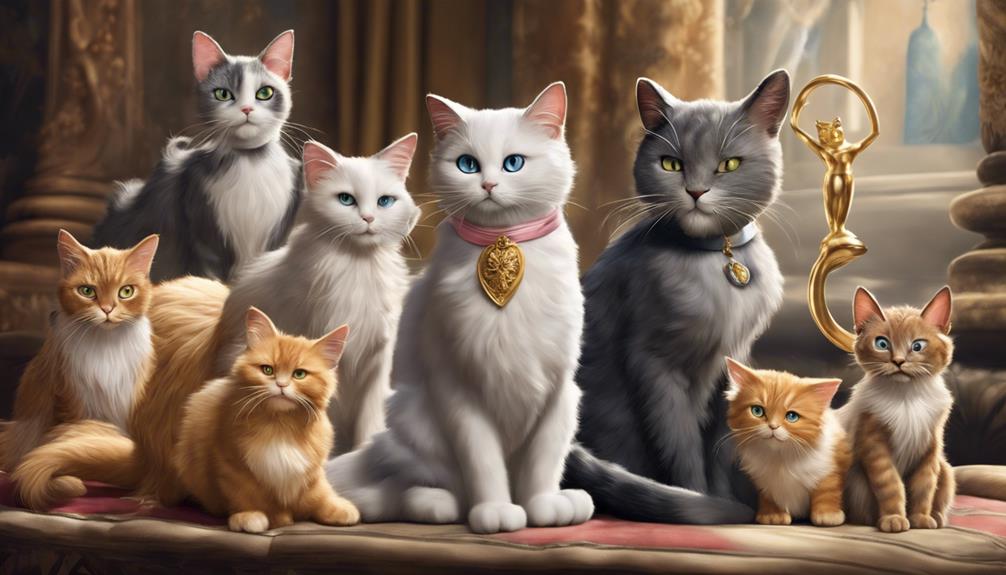
In the realm of movies, iconic female cats have captivated audiences with their memorable roles. From Holly Golightly's Cat in "Breakfast at Tiffany's" symbolizing companionship to Church bringing sinister vibes in "Pet Sematary," these feline characters steal the show. Jonesy in "Alien" provides comfort in a sci-fi horror setting, while Goose shines in "Captain Marvel" with adorableness and plot importance. Films like "The Adventures of Milo and Otis" and "Harry Potter" also feature beloved cat characters worth mentioning. Each of these famous female cats brings a unique charm to their respective films, adding depth and entertainment.
Key Takeaways
- Holly Golightly's Cat from "Breakfast at Tiffany's" is an iconic feline character symbolizing companionship.
- Church from "Pet Sematary" is a dark and transformative cat with sinister consequences in the narrative.
- Jonesy from "Alien" provides comfort and hope amid extraterrestrial danger, becoming a symbol of humanity.
- Milo and Otis from "The Adventures of Milo and Otis" showcase the escapades and talents of animal actors.
- Goose from "Captain Marvel" steals the spotlight with adorable appearance, crucial plot role, and unique origin from comics.
Breakfast at Tiffanys (1961)
In 'Breakfast at Tiffany's' (1961), we meet Holly Golightly, a flighty and cat-obsessed character who shares a special bond with her ginger tabby named Cat.
Cat, the feline companion of Holly Golightly, isn't just any ordinary cat in the movie but a symbol of companionship and attachment. Holly affectionately refers to Cat as her 'poor slob without a name,' showcasing her deep connection to the ginger tabby.
Throughout the film, the relationship between Holly Golightly and Cat highlights themes of love, freedom, and the search for identity. Cat's presence not only adds warmth and humor to the storyline but also reflects Holly's own feelings of isolation and longing for connection.
As we follow the adventures of Holly and Cat in 'Breakfast at Tiffany's,' we're drawn into a world where love knows no bounds, even between a quirky socialite and her beloved ginger tabby.
Pet Sematary (1989 and 2019)
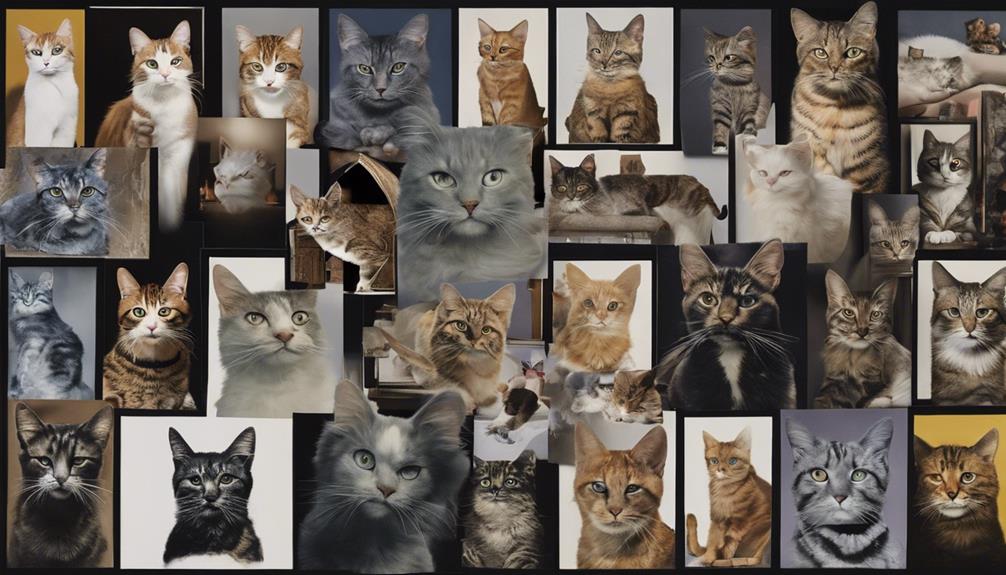
Church, the iconic feline character in both the original 1989 movie and the 2019 remake of Pet Sematary, embodies loyalty and eeriness as it undergoes a dark transformation after burial in the mysterious graveyard.
In the 2019 adaptation, four different cats were employed to bring Church to life, emphasizing the significance of this feline actor in the narrative. Church's presence in both versions of Pet Sematary adds a chilling and supernatural element to the story, captivating audiences with its haunting portrayal.
The cat character of Church serves as a poignant reminder of the sinister consequences that arise when the natural order of life and death is disrupted. Through its unsettling transformation, Church becomes a symbol of dread, leaving a lasting impression on viewers.
Pet Sematary continues to stand out in the realm of horror movies, largely due to the captivating performance of Church, the enigmatic and unsettling feline at the heart of the tale.
Alien (1979)
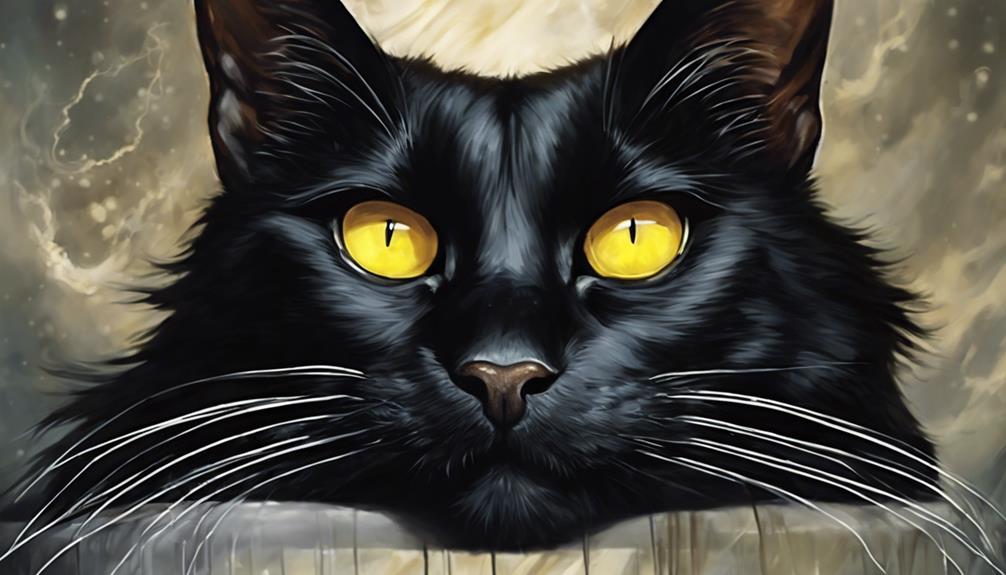
In the movie Alien (1979), Jonesy the ginger cat becomes an iconic character, influencing memorable movie moments.
Jonesy's presence not only provides comfort to the crew but also showcases the bond between humans and animals in the face of extraterrestrial danger.
The cat's role adds a unique and endearing aspect to the sci-fi horror film.
Iconic Alien Character
How did Jonesy, the ginger cat from Alien (1979), impact the atmosphere aboard the Nostromo spaceship?
Well, let's paint you a picture:
- Picture Jonesy's soft fur gently brushing against the crew's hands, offering solace in the midst of chaos.
- Imagine the soothing purrs resonating through the dimly lit corridors, a beacon of comfort in the eerie silence.
- Visualize the crew members finding moments of respite as they interacted with Jonesy, a reminder of the world beyond the spaceship's metal walls.
- Envision the subtle wag of Jonesy's tail, a small gesture that spoke volumes about the power of companionship in the face of unknown terrors.
Jonesy's presence wasn't just that of a pet; it was a symbol of hope and humanity in a world overrun by alien nightmares.
Female Cats Influence
Among the notable female cats in movies, Jonesy from Alien (1979) stands out for her impactful role aboard the Nostromo spaceship. Jonesy, the ginger cat, provided comfort and companionship to the crew, offering a sense of normalcy amidst the terror of the alien threat. Her survival instincts and agility were crucial in aiding the crew through perilous situations.
The bond between Jonesy and Ripley highlighted the importance of human-animal connections in times of crisis. Despite being a non-speaking character, Jonesy's actions and presence significantly contributed to the film's atmosphere and dynamics. The subtle interactions between Jonesy and the crew added depth to the storyline, showcasing the importance of compassion and unity in the face of danger.
Memorable Movie Moments
One standout moment in Alien (1979) that continues to captivate audiences is the intense confrontation between Ripley and the alien in the cramped confines of the spaceship.
Ripley's heart races as she faces the sleek, otherworldly Alien in a battle of survival. The Nostromo's dimly lit corridors amplify the tension, echoing with the sound of Ripley's quickened breaths. The Alien's hisses pierce the silence, signaling imminent danger to Ripley and her crewmates. Jonesy, the loyal ginger cat, watches from a safe distance, a silent witness to the unfolding chaos, offering a sense of companionship amidst the terror.
This scene not only highlights the film's suspense but also emphasizes the importance of companionship, even in the face of unimaginable threats.
The Adventures of Milo and Otis (1989)
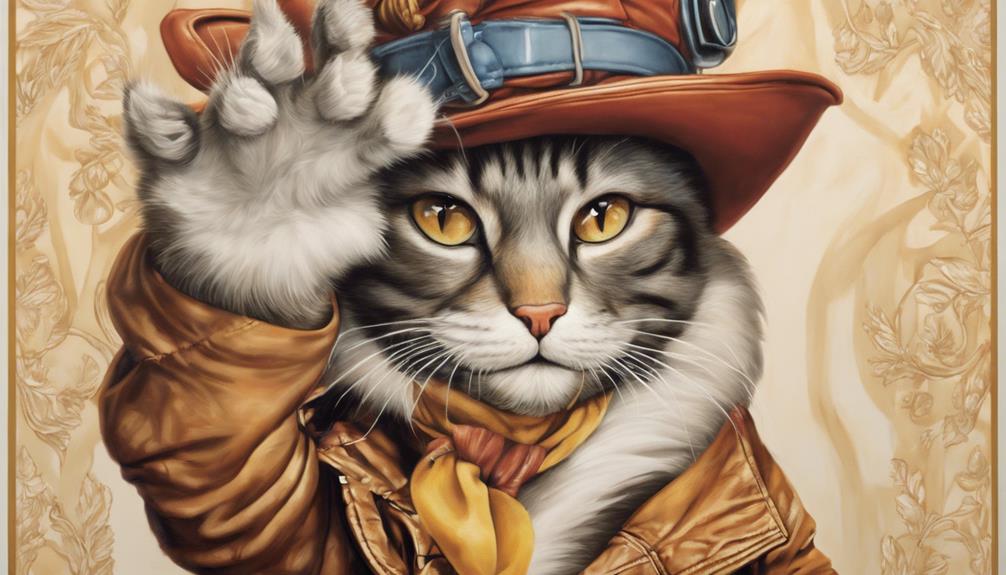
'The Adventures of Milo and Otis' (1989) follows the captivating escapades of a cat named Milo and a pug named Otis, originating from a Japanese film and gaining cult status despite controversies surrounding animal welfare during production.
This family-friendly movie showcases the incredible talent of animal actors, delivering impressive stunts and heartwarming performances that have captured the hearts of viewers over the years.
Despite facing allegations of animal cruelty, the film remains a beloved choice for animal lovers due to the endearing moments shared between Milo the cat and Otis the pug.
The movie's mix of adventure, friendship, and heartwarming scenes has solidified its place as a classic in the realm of cat movies.
Fans of animal-centric films will appreciate the genuine connection between the two main characters, making 'The Adventures of Milo and Otis' a must-watch for those seeking a wholesome and entertaining movie experience.
Captain Marvel (2019)

Goose steals the spotlight in Captain Marvel (2019), showcasing his adorable appearance and unexpected abilities as a Flerken.
- As a Flerken, Goose resembles an ordinary cat but possesses dangerous abilities that surprise and captivate audiences.
- Throughout the movie, Goose's actions aren't only adorable but also crucial to the plot, making him a beloved character among fans.
- The character of Goose is actually based on Chewie from the Captain Marvel comics, with some unique modifications that add depth to his role.
- Goose's presence in the film extends beyond just being a cute pet; he plays a significant part in key moments, solidifying his importance in the storyline.
Fans have embraced Goose with open arms, leading to merchandise and widespread popularity within the Marvel Cinematic Universe. His charm and unexpected nature make him a standout character in Captain Marvel, adding a delightful twist to the superhero narrative.
The Princess Diaries (2001)

Playing a pivotal role in The Princess Diaries (2001), Fat Louie emerges as the iconic male cat known for his playful and regal demeanor alongside Mia Thermopolis. As Mia's royal companion, Fat Louie steals scenes with his charming presence, adding humor and charisma to the film. His memorable moments have made him a fan favorite, captivating audiences with his endearing antics.
Whether lounging in regal fashion or playfully engaging with Mia, Fat Louie's unique personality shines through, creating a special bond with viewers. The dynamic between Mia Thermopolis and Fat Louie showcases a heartwarming connection that adds depth to the storyline, making their interactions a delightful aspect of the movie.
With his expressive feline features and lovable antics, Fat Louie brings a touch of whimsy and joy to The Princess Diaries, solidifying his place as a beloved character in the hearts of many.
Inside Llewyn Davis (2013)
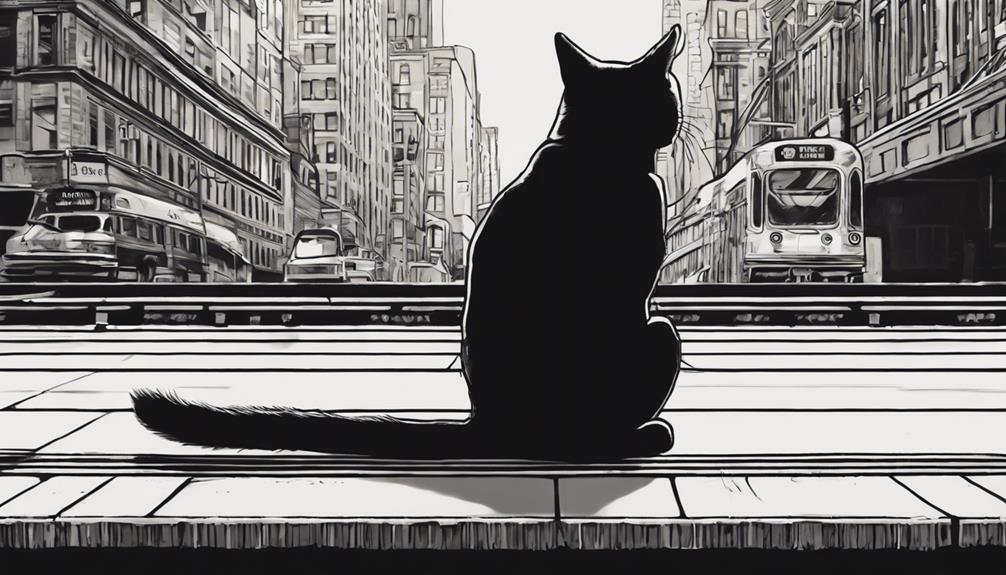
In Inside Llewyn Davis (2013), a cat named Ulysses takes on a significant role, symbolizing the struggles and journey of the film's protagonist. Ulysses, portrayed by multiple look-alike cats, seamlessly weaves through the storyline, adding depth to the relationship dynamics between characters.
Here's a glimpse into Ulysses' impact:
- Ulysses, with his enigmatic gaze, mirrors the internal turmoil of Llewyn Davis, reflecting his inner conflicts and uncertainties.
- The feline's independent nature resonates with Llewyn's own sense of isolation and longing for connection in the bustling cityscape.
- Through playful interactions with Ulysses, viewers witness moments of vulnerability and tenderness in Llewyn that are otherwise hidden beneath his tough exterior.
- Ulysses' presence acts as a silent observer, shedding light on the unspoken emotions and intricate ties that bind the characters together in this poignant tale.
The subtle yet profound role of Ulysses adds a layer of complexity to the narrative, making him an integral part of the emotional tapestry within Inside Llewyn Davis.
Kikis Delivery Service (1989)
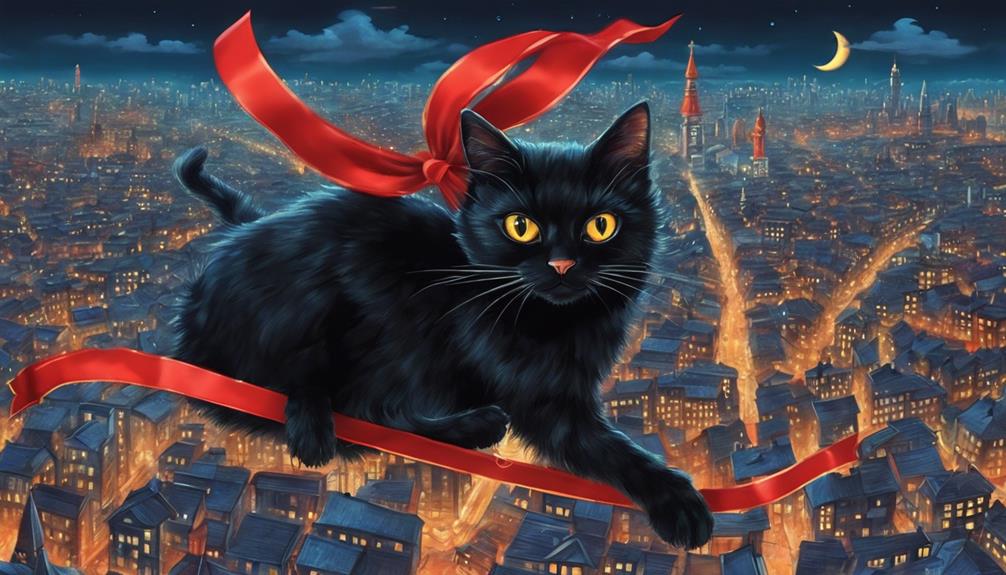
In 'Kiki's Delivery Service' (1989), Kiki's magical flying broom steals the show, but let's not forget about Jiji, the sassy cat who adds humor and sass to the storyline.
The dynamic between Kiki and Jiji showcases a bond that goes beyond words, highlighting the importance of companionship in the magical world they navigate together.
Jiji's witty and supportive nature complements Kiki's journey, making them a memorable duo in this heartwarming tale.
Kikis Magical Flying Broom
Kiki's magical flying broom in 'Kiki's Delivery Service' (1989) serves as a vital tool for the young witch's journey of self-discovery and growth, enabling her to navigate the skies with independence and determination.
- As Kiki zooms through the clouds on her broom, the wind tousles her hair, emphasizing her freedom.
- The broom's sleek design reflects Kiki's elegance and grace as she soars above the picturesque landscapes.
- With each delivery she makes on her broom, Kiki gains confidence in her abilities and strengthens her sense of self.
- The broom's enchanting flight symbolizes Kiki's transition from uncertainty to embracing her magical heritage and purpose.
Kiki's magical flying broom not only aids her in her deliveries but also acts as a metaphor for her personal journey towards maturity and self-realization.
Jiji the Sassy Cat
Jiji the sassy black cat, known for his witty remarks and loyal companionship to Kiki, plays a significant role in the animated film 'Kiki's Delivery Service' (1989). Voiced by the talented Phil Hartman in the English dub, Jiji's humorous banter with Kiki adds depth and humor to the story.
Throughout the movie, Jiji helps Kiki adapt to her new surroundings and supports her in her delivery service endeavors. His charming personality and strong bond with Kiki make him a standout character, showcasing the importance of animal companionship and friendship.
Jiji's presence not only provides comedic relief but also underscores the theme of loyalty and support. In the world of animated films, Jiji has become an iconic and beloved feline figure, cherished for his role in Kiki's journey.
Harry Potter Series

Half-Kneazle Crookshanks, Hermione's loyal and intelligent cat in the Harry Potter series, plays a crucial role in exposing Peter Pettigrew's true identity in the Prisoner of Azkaban. Crookshanks' distinctive appearance with bushy fur, squashed face, and piercing amber eyes adds to his mysterious charm.
Here are some fascinating facts about Crookshanks:
- Sharp Intelligence: Crookshanks is known for his exceptional intelligence, which aids Hermione and the gang in solving intricate mysteries.
- Loyalty to Hermione: Crookshanks displays unwavering loyalty to Hermione, supporting her through thick and thin in their magical adventures.
- Pottermore Mention: J.K. Rowling herself highlighted Crookshanks' significance in aiding Sirius Black during the tumultuous events of the Prisoner of Azkaban.
- Instrumental Role: Beyond being a mere pet, Crookshanks proves to be an instrumental character in the series by helping unveil the true intentions of Peter Pettigrew, ultimately changing the course of events in the wizarding world.
Homeward Bound: The Incredible Journey (1993)
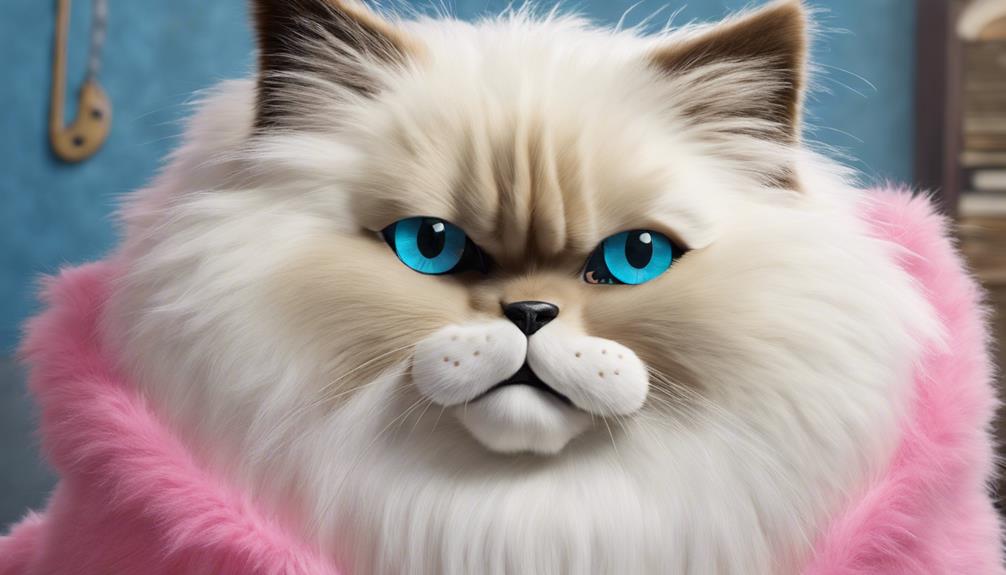
Sassy, the determined and loyal feline from Homeward Bound: The Incredible Journey (1993), joins two dogs on a cross-country adventure in search of their family.
Voiced by Sally Field, Sassy's character brings humor and excitement to the heartwarming journey.
Her resourcefulness and interactions with the dogs make her a beloved and memorable part of the film.
Top Female Cat Characters
Embarking on a cross-country journey with two dogs, the tenacious and adventurous female cat in 'Homeward Bound: The Incredible Journey' (1993) adds a unique charm to the heartwarming animal adventure. Voiced by Sally Field, Sassy's determination and courage make her a memorable character in the film. Here's why she stands out:
- Sassy fearlessly navigates through various challenges, showcasing her bravery.
- Her witty remarks and sassy attitude bring humor and liveliness to the group dynamics.
- Sassy's interactions with the dogs and other animals highlight her caring nature.
- Sally Field's vocal performance breathes life into Sassy, giving depth to the feline character's personality.
Homeward Bound Representation
Representing a tale of friendship and determination, 'Homeward Bound: The Incredible Journey (1993)' portrays the inspiring journey of Sassy, a tenacious cat, and her loyal canine companions searching for their family across the country.
Sassy's unwavering determination and resourcefulness shine through as she overcomes obstacles alongside her canine pals. Voiced by the talented Sally Field, Sassy's character adds humor and sass to the group dynamic, making her a beloved part of this heartwarming family film.
Throughout the perilous journey, Sassy's loyalty and courage are evident, showcasing her as a standout character who embodies the spirit of resilience and companionship. This classic movie captures the essence of unity and perseverance, making Sassy a memorable feline heroine in the world of cinema.
Frequently Asked Questions
Who Is the Most Famous Fictional Cat?
We believe the most famous fictional cat is Garfield. Created in 1978 by Jim Davis, Garfield's known for loving lasagne, hating Mondays, and delivering witty sarcasm. Appearing in comics, TV, and movies, Garfield's an enduring cultural icon.
What Is the Most Famous Cat in Hollywood?
We believe the most famous cat in Hollywood is Jonesy from 'Alien' (1979). Jonesy, an orange tabby, brings comfort and tension in the sci-fi horror film. His loyalty and unpredictability make him iconic, enhancing the storyline.
Who Is the Famous Crazy Cat Lady?
We know the famous crazy cat lady you're curious about. She's an iconic character, deeply entwined with feline companions. Her eccentricity and love for cats captivate us all. Let's uncover her intriguing story together.
Who Is the Most Famous Cat of All Time?
We believe the most famous cat of all time would be Garfield. He's iconic for his love of lasagne and disdain for Mondays, charming audiences with his wit and humor in movies, TV shows, and comics.
Conclusion
In the world of movies, female cats have left a lasting paw print on our hearts. From the iconic Holly Golightly's feline companion in 'Breakfast at Tiffany's' to the mysterious Jonesy in 'Alien,' these purr-fect stars have stolen the show.
Just like cats have nine lives, these famous feline characters have brought joy and entertainment to audiences of all ages. Their whiskers may be fictional, but their impact is very real.
Paul’s love for animals knows no bounds. As a dedicated writer and animal lover, Paul brings a unique perspective to our team. His firsthand experiences with various animals enrich our content and provide valuable insights into their behavior and needs. Whether he’s sharing tips for pet care or shedding light on pressing conservation issues, Paul’s passion for animals shines through in everything he does.
Cats
Friendly Black Cats: A Complete Guide
Packed with insights on friendly black cats, this complete guide promises to unravel the mysteries behind these enchanting feline companions.

Curious about friendly black cats? From Bombay to Maine Coons, these felines are sociable and affectionate companions. Grooming with a soft brush prevents matting, supported by tailored care products. Regular vet check-ups keep dental and skin issues at bay. Finding the perfect match involves family compatibility and behavioral assessments. Bonding? Use positive reinforcement techniques and provide cozy hideaways. For fun, try interactive toys and DIY options. Challenge myths about black cats; they're symbols of good luck! Owning one can bring positivity. Discover more about these enchanting creatures by exploring our complete guide.
Key Takeaways
- Black cats like Bombay, Chantilly-Tiffany, and Maine Coons are known for their friendly and sociable nature.
- They form strong bonds with their owners and have gentle, patient, and affectionate temperaments.
- Regular grooming with a soft brush and tailored products ensures a shiny coat.
- Preventive care like regular vet check-ups and a healthy diet helps avoid common health issues.
- Understanding their body language, providing cozy spots, and positive reinforcement build a lasting bond.
Black Cat Breeds Overview
When exploring black cat breeds, one quickly encounters a diverse range of breeds with unique characteristics and personalities. From the sleek Bombay to the affectionate Chantilly-Tiffany, black cats come in various shapes, sizes, and temperaments.
The Persian, with its glossy black coat and daily grooming needs, stands out alongside the gentle giants known as Maine Coons, famous for their climbing prowess. Additionally, the Rex breeds offer unique coat textures and quirky personalities, with each type like the Cornish Rex, Selkirk Rex, and Devon Rex bringing something special to the table.
Shorthair breeds such as the American and British Shorthair aren't only popular but also easygoing companions for any black cat enthusiast. Lastly, the sociable and intelligent Bobtail breeds like the Japanese Bobtail and American Bobtail add a touch of charm to the mix, making them stand out among the plethora of black cat options available.
Characteristics and Temperament
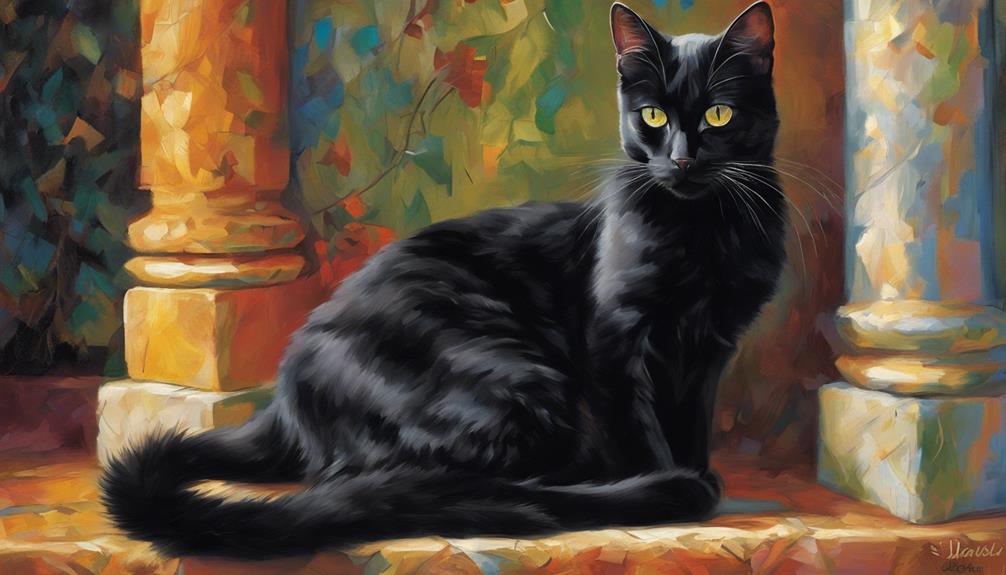
Black cats exhibit a friendly and sociable nature, seeking attention and companionship from their owners. These lovable felines come in a range of personalities, but many are known for being gentle, patient, and affectionate. They make wonderful companions for families with children or other pets due to their adaptable and easygoing nature. Friendly black cats aren't only loyal but also form strong bonds with their owners, showing their love through purring, cuddling, and playful antics. Their expressive personalities make it easy for owners to understand and connect with them on a deeper level.
Whether you live in a small apartment or a spacious house, these cats are well-suited for various living environments. Owners who keep friendly black cats often find themselves with a devoted and loving companion who brings joy and warmth to their home. It's no wonder these delightful creatures are cherished by so many.
Care and Grooming Tips
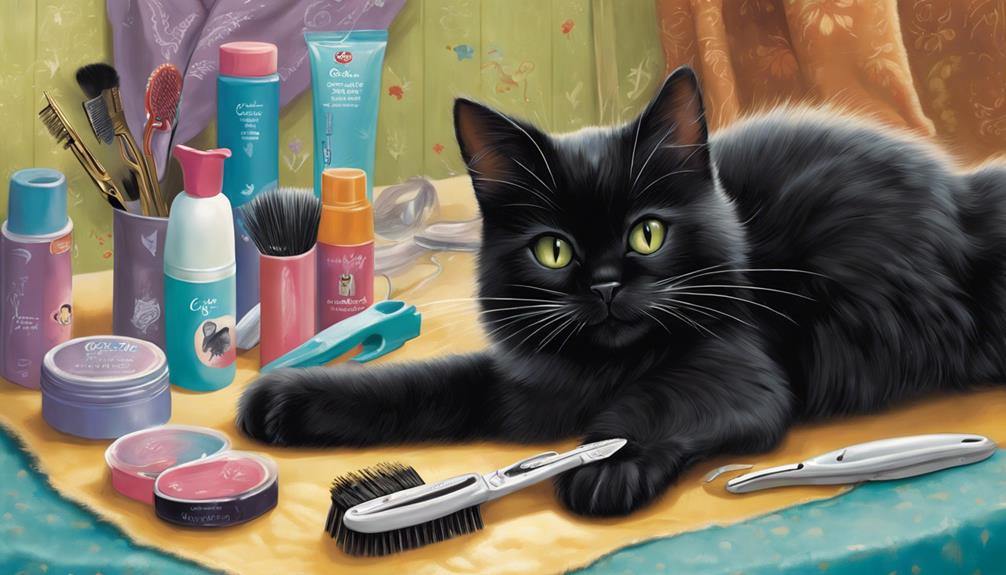
Regular grooming is essential for maintaining the shine and health of a black cat's coat. Using a soft brush is key to prevent damaging their fur and to remove any loose hairs gently. When grooming your black cat, pay close attention to areas like behind the ears and under the armpits where matting can occur.
Black cats, with their dark coats, may require more frequent grooming to keep their fur from appearing dull or unkempt. It's advisable to seek guidance from a veterinarian for specific grooming tips and products tailored to black cat care.
Health Concerns and Prevention
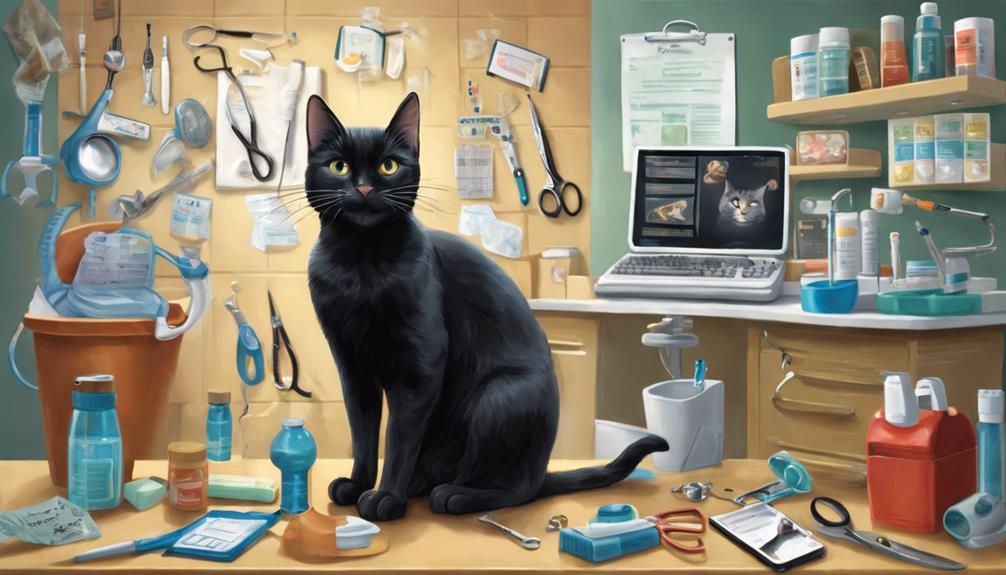
Regular veterinary check-ups are crucial for monitoring our black cat's health and catching any potential issues early.
We must also prioritize regular dental care, including brushing their teeth, to prevent dental problems.
Maintaining a healthy diet and providing regular exercise are essential in preventing obesity and weight-related health issues in our black cats.
Common Health Issues
Dental problems, obesity, and skin conditions are prevalent health issues that commonly affect black cats. Proper dental care, such as regular teeth cleanings, can help prevent issues like periodontal disease.
Obesity can lead to various health concerns, so monitoring your black cat's diet and ensuring they get enough exercise is crucial.
Additionally, keeping an eye out for any skin conditions, like allergies or infections, is important for their overall well-being.
While these are common health issues, with proper care and attention, you can help your black cat lead a healthy and happy life.
Regular veterinary check-ups play a key role in catching any potential problems early on, ensuring your feline friend stays in top shape.
Preventive Care Measures
Ensuring proper preventive care measures for black cats is essential in maintaining their overall health and well-being. Regular veterinary check-ups are crucial for early detection of potential health issues. A balanced diet and weight management help prevent obesity-related problems. Providing a safe environment for exercise and mental enrichment boosts their well-being. Vaccinations and parasite control protect black cats from diseases and infestations. Monitoring for changes in behavior and seeking prompt veterinary care are key in addressing health concerns effectively. Here is a helpful table to guide you on preventive care measures:
| Preventive Care Measures | Benefits |
|---|---|
| Regular Check-ups | Early detection of health issues |
| Coat Care | Maintains healthy skin and fur |
| Vaccinations | Protection against common diseases |
Finding the Perfect Match
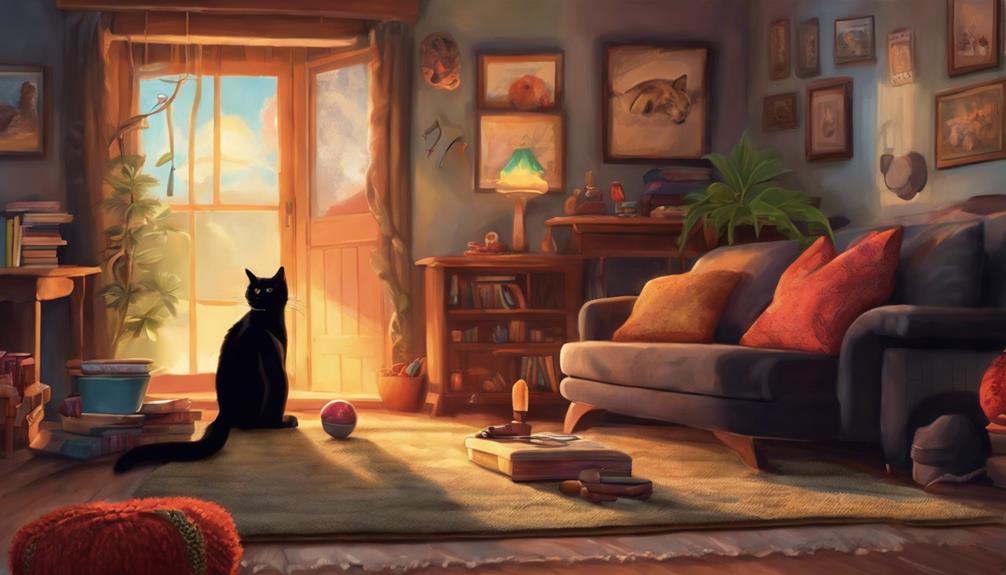
When looking to find the perfect match in a black cat, it's essential to consider:
- Adoption considerations
- Compatibility with family members
- Behavioral assessment techniques
Understanding these key points can help ensure a smooth integration of your new feline companion into your household. By evaluating these factors, you can make an informed decision that aligns with your lifestyle and preferences.
Adoption Considerations
To find the perfect match when considering adoption, assess the personality traits and energy levels of black cat breeds to align with your lifestyle. It's essential to consider the existing pets or children in your home to ensure a smooth transition for everyone.
Look into shelters, rescue organizations, and breed-specific rescues to find your new feline companion. Evaluate your living space to make sure it's suitable for a black cat's needs, providing a safe and stimulating environment.
Discuss health and care requirements with adoption centers to understand what it takes to care for a black cat properly. By taking these adoption considerations into account, you can increase the chances of a successful and fulfilling adoption experience for both you and your new furry friend.
Compatibility With Family
Considering the compatibility of black cat breeds with your family is crucial for finding the perfect match. When selecting a feline friend, make sure to take into account your family's lifestyle and preferences.
For families with children, breeds like the Chantilly-Tiffany and Ragamuffin, known for their patience and friendliness, are excellent choices. If you have an active household, the Oriental breed, with its energetic nature and desire for attention, could be a great fit.
Families seeking a more laid-back companion might enjoy the docile Persian with its high-maintenance grooming needs. Sphynx cats, despite their unique appearance, can form strong bonds with family members, while the Exotic shorthair's thick coat and loyalty make it a good match for those looking for a quieter pet.
Behavioral Assessment Techniques
Understanding a cat's behavior through observation in various contexts is key to finding the perfect feline match for your family. When assessing a cat's personality, observational techniques play a crucial role. Here are some ways to conduct effective personality assessments:
- Observe how the cat responds to different stimuli: Pay attention to their reactions to toys, sounds, and movements.
- Interact with the cat: Engage in playtime and see how they interact with you.
- Note their behavior around other animals: See how they behave around other pets to gauge their sociability.
- Assess their overall demeanor: Take note of their energy level, temperament, and body language.
- Consider their lifestyle compatibility: Match their traits with your family's lifestyle and preferences.
Bonding With Your Black Cat
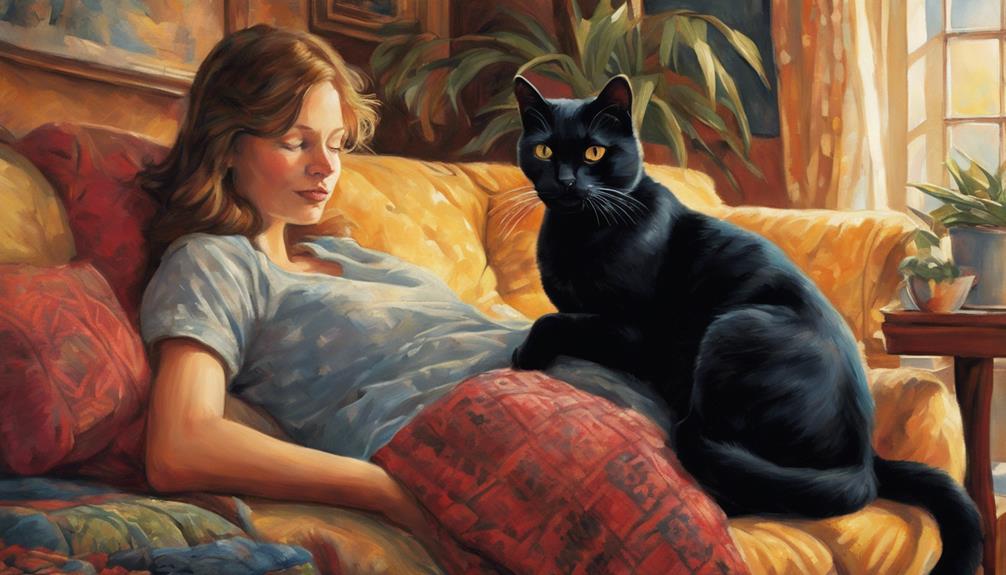
Bond with your black cat by engaging in interactive play sessions and grooming to strengthen your bond. By spending quality time together, you can deepen the connection between us and create a sense of trust and companionship.
When interacting with your black cat, use soft tones and positive reinforcement to support you through every step of the bonding process. Communication is key in building a strong relationship with your feline friend.
Ensure that the environment is safe and comfortable, providing cozy hiding spots and vertical spaces for exploration. Understanding your black cat's body language and cues will help us interpret their needs and emotions accurately during our bonding experiences.
Remember to respect their individual personality and preferences, allowing them to take the lead in interactions and express their unique traits. By following these tips, you can foster a loving and lasting bond with your black cat.
Training and Socialization Tips
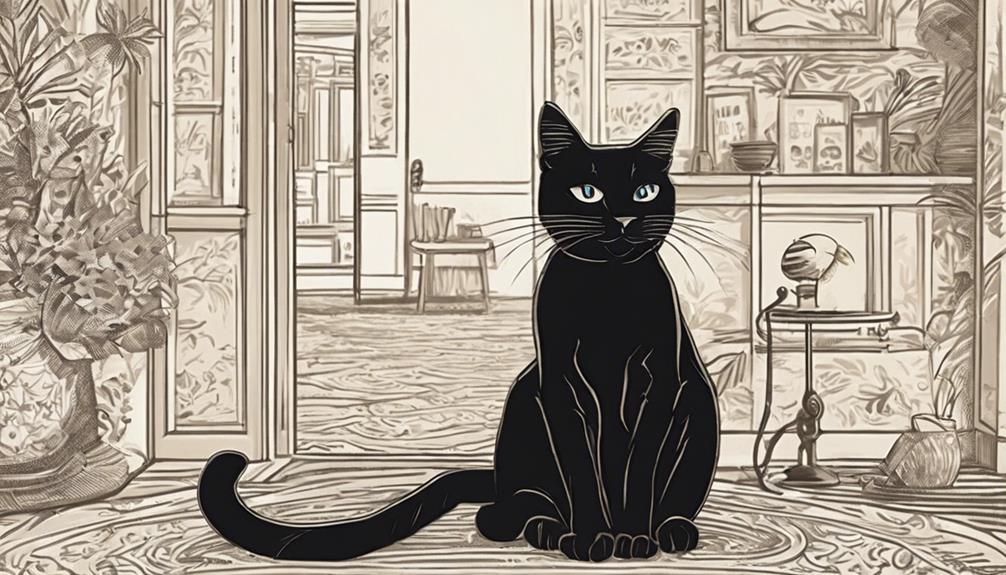
When training and socializing your black cat, incorporating positive reinforcement techniques is key to encouraging desired behaviors and fostering a well-adjusted companion. Here are some tips to help you effectively train and socialize your feline friend:
- Start Early: Begin training and socialization when your black cat is young to ensure they become well-adjusted and friendly.
- Use Positive Reinforcement: Reward good behavior with treats and praise to reinforce positive actions.
- Provide Socialization Opportunities: Introduce your cat to other pets, people, and environments to help them feel comfortable and confident.
- Establish Routine: Create a consistent schedule for training sessions and social interactions to provide structure for your black cat.
- Seek Professional Help: Don't hesitate to consult a trainer or behaviorist if you face challenges or need guidance with training and socialization.
Fun Activities and Toys
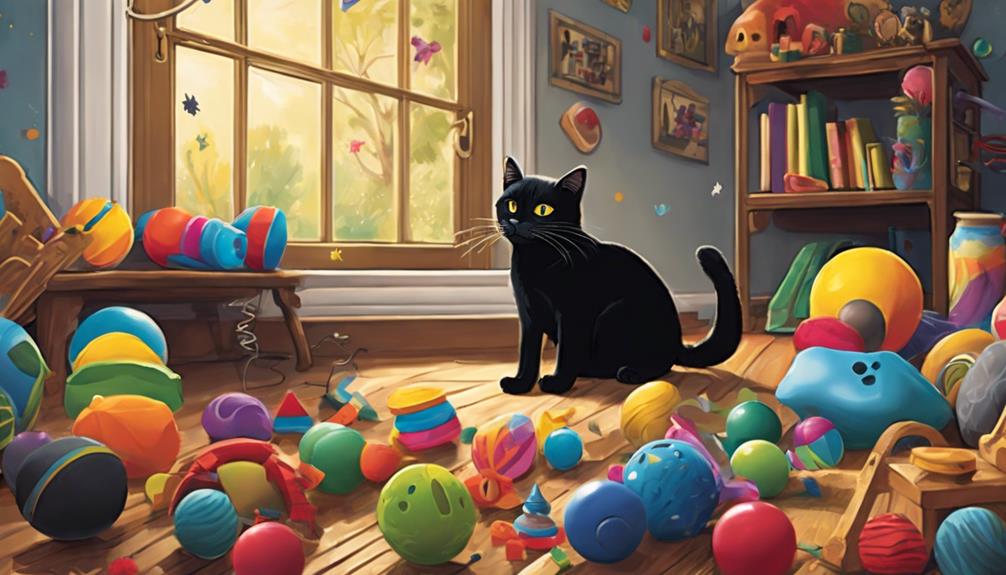
To engage and entertain black cats, incorporating a variety of interactive toys and activities into their daily routine is essential. Interactive toys like laser pointers and feather wands provide mental and physical stimulation for our feline friends. Puzzle feeders and treat-dispensing toys engage their natural hunting instincts, preventing boredom. Cat trees and climbing towers offer opportunities for exercise, play, and curiosity satisfaction in a safe setting. It's important to rotate toys regularly to keep our black cats interested and prevent them from getting bored. DIY toys such as crinkle balls, cardboard boxes, and homemade puzzle toys can be cost-effective and entertaining alternatives.
At our in-house, we've articles tailored to help you choose the best toys for your black cat. Ensuring access to a variety of toys and activities is key to keeping your black cat healthy, happy, and mentally stimulated. By incorporating these fun activities into their daily routine, you can provide your black cat with the enrichment they need to thrive.
Black Cat Myths Debunked
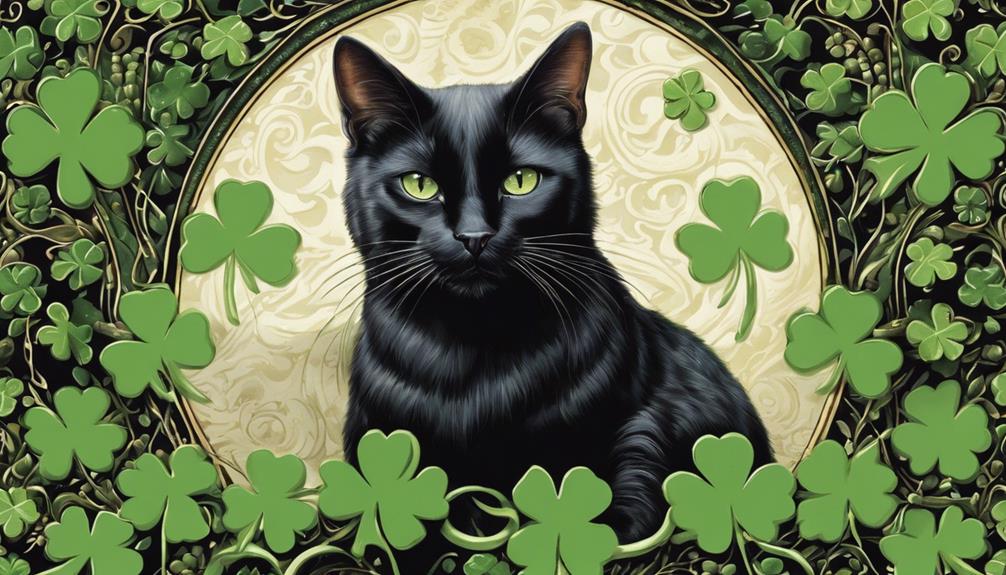
Contrary to popular belief, black cats aren't omens of bad luck but rather revered symbols of good fortune in various cultures worldwide. It's time to debunk these myths and shed light on the truth about our ebony feline friends.
- Black cats aren't omens of bad luck; instead, they're symbols of good luck in many cultures.
- Superstitions surrounding black cats have a long history, leading to discrimination and harm against these gentle creatures.
- Despite their loving nature, black cats are often overlooked for adoption due to these superstitions.
- Education is crucial in dispelling these misconceptions perpetuated by popular culture.
- Many people believe that owning a black cat can bring positivity and protection into their lives, challenging the negative myths associated with them.
Frequently Asked Questions
Are Black Cats the Friendliest?
We believe all cats, regardless of color, can be just as friendly. Personality traits depend on genetics, socialization, and individual temperament, not coat color. Black cats, like any others, can be affectionate and loyal.
What Is the Black Cat Rule?
We believe the Black Cat Rule is a superstition influencing how black cats are perceived. Some see them as lucky charms, others as signs of bad luck. Despite this, black cats are simply feline friends with unique traits.
Are Completely Black Cats Rare?
Completely black cats are not rare; breeds like Bombay and Oriental are dedicated to this color. They possess glossy coats and are full of energy, seeking attention. Sphynx cats, despite being hairless, are playful and bold.
What Is the Most Popular Black Cat Breed?
We adore the sleek Bombay cat for its panther-like beauty. Chantilly-Tiffany cats charm with their affectionate nature. Persian cats captivate with glossy black coats. Maine Coons win hearts with gentle personalities. Each breed has unique allure.
Conclusion
In conclusion, black cats aren't just sleek and elegant creatures, but also loving companions who bring joy and comfort to our lives.
Remember, just like diamonds in the rough, these friendly felines may have a mysterious aura, but they're full of warmth and affection once you get to know them.
So, if you're considering adding a black cat to your family, be prepared for a lifetime of love and companionship.
Paul’s love for animals knows no bounds. As a dedicated writer and animal lover, Paul brings a unique perspective to our team. His firsthand experiences with various animals enrich our content and provide valuable insights into their behavior and needs. Whether he’s sharing tips for pet care or shedding light on pressing conservation issues, Paul’s passion for animals shines through in everything he does.
Cats
Why Does My Cat Stare at Me With Big Pupils?
Uncover the mystery behind your cat's intense gaze with big pupils and discover what emotions or messages they might be trying to convey!

When your cat stares at you with big pupils, it's likely expressing intense emotions like excitement, surprise, fear, or even affection. Those dilated eyes can signal curiosity or heightened interest in their surroundings. Sometimes, it's a way of showing a deep emotional bond with you. However, prolonged staring could indicate fear or stress. Understanding these subtle cues can strengthen your connection with your feline friend. But there's more to discover about your cat's staring behavior beyond just emotions.
Key Takeaways
- Big pupils signal intense emotions like excitement, fear, or curiosity.
- Cat staring with dilated eyes shows heightened interest or alertness.
- Understanding cat body language is crucial for interpreting their emotions.
- Dilated pupils may hint at underlying medical issues.
- Eye contact and pupil size reveal feelings, intentions, and emotional well-being.
Reasons for Cat Staring Behavior
When observing a cat staring at you with big pupils, it's crucial to understand the reasons behind this behavior. Cats communicate a lot through their body language, and dilated pupils can signal various emotions such as excitement, surprise, or fear.
Imagine those big, round eyes fixed on you – it could mean your feline friend is highly stimulated or experiencing intense emotions. In some cases, dilated pupils indicate that your cat is alert and focused on something specific.
However, it's essential to note that dilated pupils might also be a sign of an underlying medical issue. While most often, big pupils are harmless and related to emotional states, sometimes they can hint at health concerns that need attention. So, it's always wise to observe your cat's behavior holistically, considering the context and other signs they might be displaying. Understanding your cat's body language can deepen your bond and ensure their well-being.
Curiosity and Cat Staring
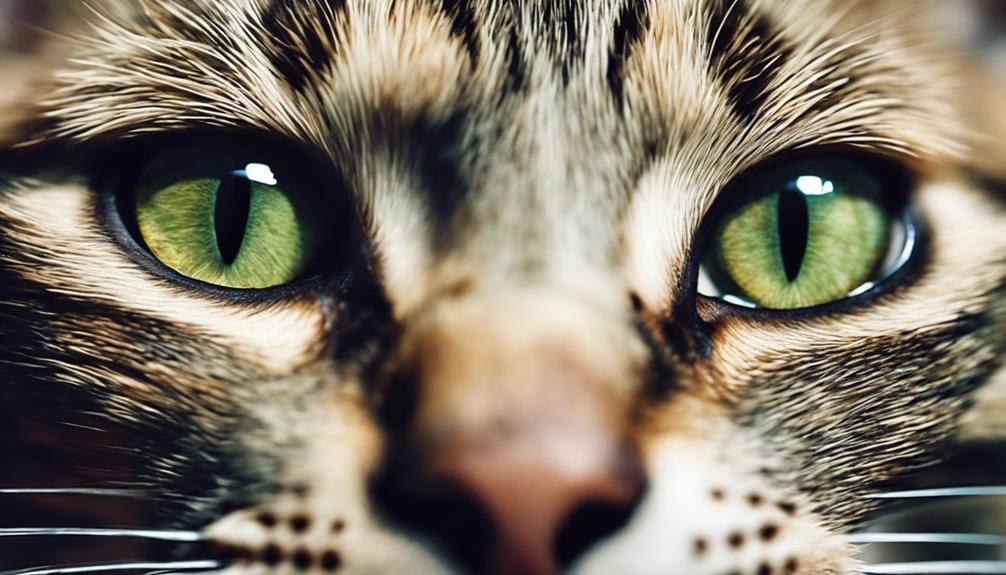
When our feline friends fix their gaze on us with those big pupils, it's their curiosity piqued.
Their intense focus and dilated eyes indicate a deep interest in what we're up to.
Cats' investigative nature shines through as they stare, absorbing all the details of their surroundings.
Curiosity in Cat Behavior
Exploring their surroundings with intense curiosity, cats often express their interest through focused staring with big pupils. Curiosity is a driving force behind a cat's behavior, pushing them to observe, learn, and engage with their environment.
When your feline friend locks eyes with you, their dilated pupils show heightened interest in what you're doing or saying. Cats rely on their keen vision and enlarged pupils to investigate new or intriguing stimuli in their surroundings.
This behavior of staring with big pupils is a common sight in curious cats as they explore and interact with the world around them. So, the next time your cat fixes you with a gaze, know that their curiosity is piqued, and they're fully engaged in understanding their surroundings.
Meaning Behind Staring
As cats stare at you with big pupils, their intense curiosity drives them to explore and understand their environment deeply. When your cat locks eyes with you, their dilated pupils show heightened interest and surprise.
This staring behavior isn't mere observation; it's a window into their excitement and anticipation. The way your cat's eyes widen indicates a genuine engagement, with their whole body focused on decoding the world around them.
Affection and Cat Staring

Expressing their affection, cats often show slow blinks while staring at their owners, a behavior that signifies love and trust in feline communication. This loving gesture can create a strong bond between a cat and its human companion.
Here are some insights into why cats exhibit such behaviors:
- Sign of Affection: Slow blinking is a clear sign that your cat feels comfortable and safe around you. It's their way of saying, 'I trust you.'
- Deep Eye Contact: When a cat maintains deep eye contact with you, it shows a level of intimacy and connection. They're trying to communicate their feelings in a non-verbal way.
- Cat Stares: Cats staring at you with big pupils can be a display of affection. The dilated pupils indicate excitement and positive emotions towards you.
- Building Trust: Through these actions, cats aim to build a strong emotional bond with their owners. Responding in kind can strengthen the relationship and enhance mutual understanding.
Understanding these behaviors can help you reciprocate your cat's affection and strengthen your bond with them.
Dominance and Cat Staring

In the world of feline social dynamics, cat staring serves as a powerful tool for establishing dominance and hierarchy among cats. Dominant cats often engage in intense eye contact, using staring as a form of communication to assert their position in the group. This behavior is crucial for reflecting the complex hierarchy and dynamics within a cat community. When a dominant cat stares down its opponent, it sends a clear message of superiority and control.
On the flip side, submissive cats tend to avoid direct eye contact with dominant cats as a sign of respect and submission. This subtle form of communication helps maintain peace and order within the group. By understanding the significance of eye contact and staring in cat behavior, we can gain insights into the relationships and interactions among these fascinating creatures.
Cat Staring Out of Fear
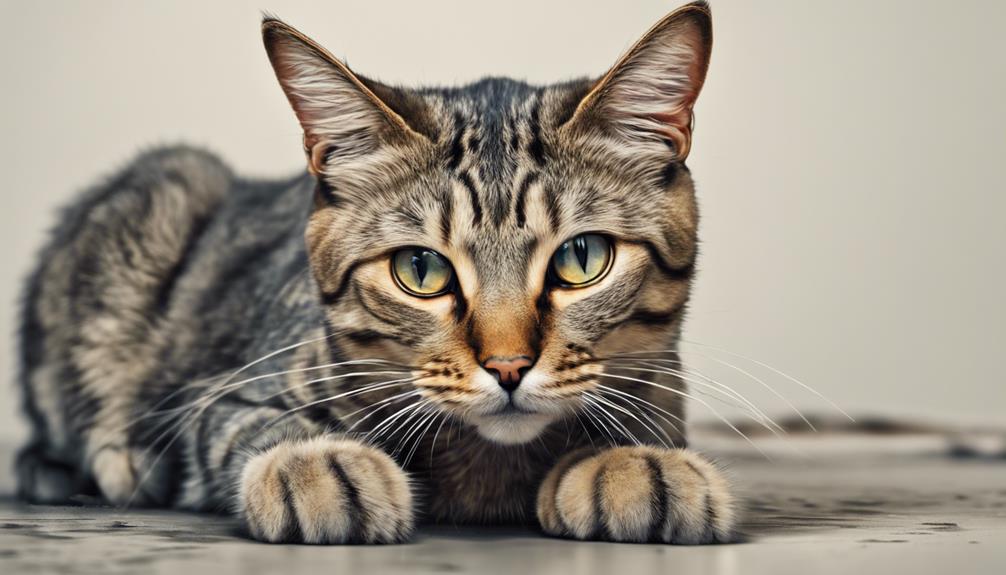
When our feline friends stare at us with big, dilated pupils, it might be a sign of fear or anxiety.
This fear-induced staring can be triggered by various factors like loud noises or unfamiliar surroundings.
Understanding these defensive postures and fearful body language cues helps us provide comfort and security to our cats in distress.
Fearful Body Language
Observing a cat with big pupils can provide valuable insights into its emotional state, particularly when it exhibits fearful body language. When a feline is feeling threatened or anxious, its body language can reveal its inner turmoil. Here are some signs to look out for:
- Dilated Pupils: Enlarged pupils can indicate heightened fear or stress in your cat.
- Flattened Ears: Ears pressed flat against the head signal discomfort or fear.
- Tense Body Posture: A rigid or tense body indicates a cat on edge.
- Avoidance Behavior: Cats may avoid eye contact, hide, or show signs of nervousness when fearful.
Understanding these cues helps in addressing and soothing your cat's anxiety, creating a safe and secure environment for your furry friend.
Defensive Postures Explained
Understanding a cat's defensive postures, like staring with big pupils, reveals its underlying fear or anxiety. When a cat displays dilated pupils while staring, it signifies heightened arousal and readiness for defensive actions.
Defensive postures can also include flattened ears, raised fur, and a tense body stance. These behaviors are often triggered when a cat feels threatened or unsafe in its environment.
Recognizing these defensive signals is crucial in responding appropriately to alleviate the cat's fear or anxiety. By understanding the signs of defensive postures, such as dilated pupils and tense body language, we can create a more secure and comforting environment for our feline companions.
Interpretation of Cat Staring
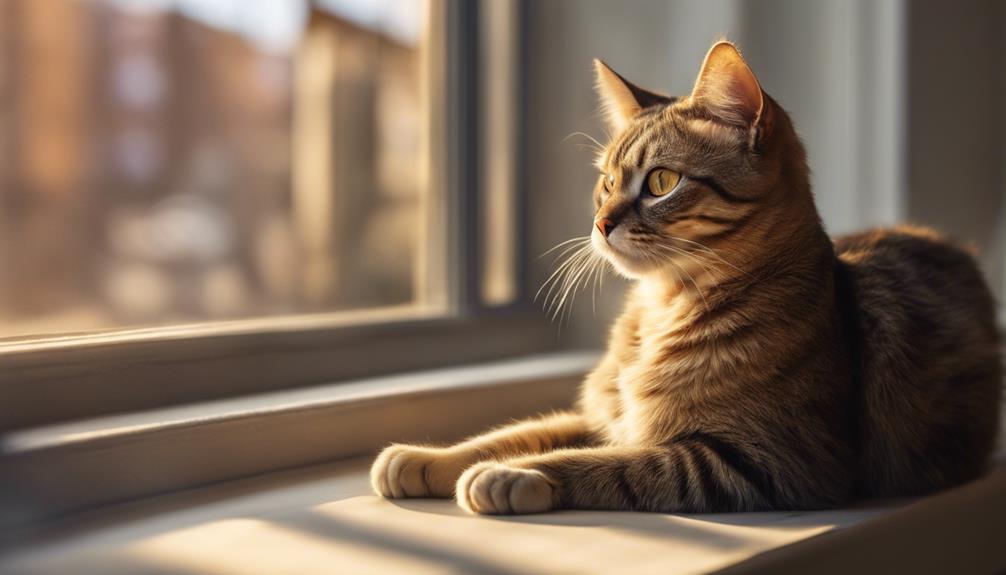
What do a cat's staring eyes reveal about their emotions and intentions? When deciphering the meaning behind a cat's intense gaze, it's essential to consider various factors that can shed light on their mood and intentions. Here's what you need to know:
- Dilated Pupils: Dilated pupils in cats often indicate excitement, surprise, or fear. Fully dilated pupils may suggest heightened arousal, so it's crucial to assess the overall body language of the cat to interpret the context accurately.
- Constricted Pupils: On the other hand, constricted pupils can signal agitation or anger in cats. If a cat with big, round eyes and pinprick pupils is staring at you, it might be a sign of potential aggression, indicating readiness to attack.
- Squinted Eyes: Cats that squint or half-close their eyes are displaying signs of affection, relaxation, and trust. This relaxed gaze resembles a sense of comfort and security, indicating positive emotions towards you.
- Eye Contact and Blinking: Establishing trust and connection with a cat can be achieved through eye contact and blinking. Blinking at a cat can convey trust and connection, with mutual blinking fostering a bond of trust and positive interaction. So, if your cat is staring at you, consider blinking back to communicate feelings of trust and affection.
Cat Staring and Communication

Cat staring serves as a nonverbal form of communication between felines and humans, conveying a range of emotions and intentions. When your cat locks eyes with you, they are trying to tell you something beyond words. Understanding this form of communication can deepen the bond between you and your furry friend. Let's delve into the significance of cat staring and how it plays a crucial role in their interactions with us.
| Emotion/Intention | Significance |
|---|---|
| Excitement | Dilated pupils may indicate your cat's enthusiasm or anticipation. |
| Fear | Big pupils while staring could mean your cat is feeling scared or anxious. |
| Curiosity | A focused gaze with dilated pupils might show your cat's interest in something. |
Cats use staring as a tool to express themselves, so pay attention to their eye signals to better understand their mood and needs. Next time your cat fixes their gaze on you with big pupils, remember, it's their way of communicating with you.
When Cat Staring Raises Concerns
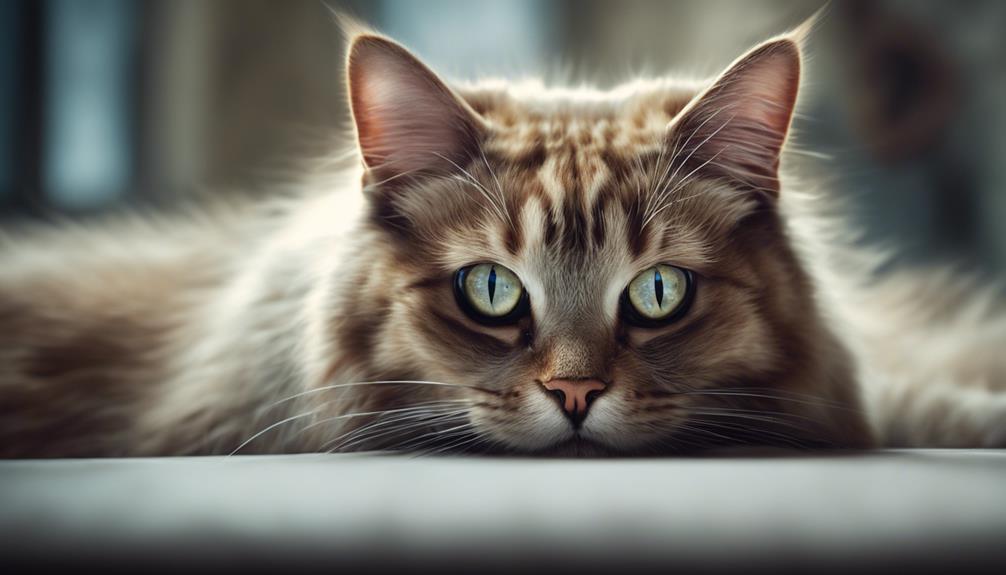
When observing a cat's prolonged and intense staring with dilated pupils, it can raise concerns about their emotional state or well-being. Here are some key points to consider:
- Interpreting Emotional State: Dilated pupils in cats can indicate a range of emotions such as excitement, surprise, or fear. Understanding these cues can help decipher what your cat might be feeling.
- Readiness to React: Big, round eyes with dilated pupils may signal that a cat is on high alert and ready to respond to a situation. It's essential to pay attention to other body language cues to grasp the full picture.
- Monitoring Changes: Keeping an eye on changes in pupil size can offer valuable insights into your cat's emotional well-being. Consistent monitoring can help in detecting any unusual behavior early on.
- Overall Body Language: Dilated pupils, when combined with other body language cues, provide a holistic view of your cat's feelings and intentions. Being mindful of these signals can help strengthen the bond between you and your feline companion.
Managing Cat Staring Behavior

When managing cat staring behavior, we can focus on techniques like eye contact training and redirecting attention positively.
By engaging in these practices, we can help our feline friends understand appropriate social cues and foster a strong bond.
Being attentive to their body language and reactions can provide valuable insights into their emotions.
Eye Contact Training
During eye contact training sessions, we gradually increase the duration of our gaze to help our feline companions get accustomed to staring without feeling threatened.
Start with short eye contact sessions and gradually extend the time.
Use positive reinforcement like treats and gentle praise to encourage your cat.
Monitor your cat's body language for signs of stress or discomfort.
Seek professional guidance if your cat continues to exhibit intense staring behavior despite training efforts.
Redirecting Attention Positively
To effectively manage cat staring behavior, redirecting attention positively through engaging interactive play sessions and providing stimulating toys is key. When your cat starts staring, try initiating a fun play session with their favorite toy or introducing a new interactive game to shift their focus.
Cats are naturally curious and playful creatures, so engaging their minds and bodies can help break the staring habit. Stimulating toys like puzzle feeders or treat-dispensing toys can also provide mental enrichment, reducing excessive staring tendencies.
Establishing a structured routine with regular playtime and interactive engagement can further discourage unwanted staring behaviors. By redirecting your cat's attention in a positive and engaging way, you can help minimize their fixation on staring.
Cat Staring: Normal or Not?

Staring intensely at you with big pupils, a cat's gaze can convey a range of emotions and intentions. When wondering if your feline friend's prolonged stare is normal behavior, consider the following:
- Emotional State: Cats staring with dilated pupils may be experiencing heightened emotions like excitement, surprise, or fear.
- Intentions: The dilation of a cat's pupils can indicate intense focus or strong emotions, depending on the context.
- Variability: Pupil dilation in cats can vary based on their mood, environment, or external stimuli.
- Interpretation: Understanding cat eye dilation is crucial in interpreting their emotional state and intentions accurately.
Cats communicate in various ways, and their eyes play a significant role in expressing feelings and thoughts. Observing their behavior, including staring with big pupils, can provide insights into their current state of mind. So, next time your cat fixes you with a penetrating gaze, remember that it's their way of sharing their emotions and intentions with you.
Frequently Asked Questions
Why Is My Cat Staring at Me With Big Eyes?
We notice our cat's big eyes staring. Those dilated pupils could reveal excitement, fear, focus, or readiness for action. When cats gaze at us intensely, they might be sharing their heightened emotions or alertness.
Why Do Cats Stare at You With Dilated Eyes?
We notice when cats stare with dilated eyes, they might feel excited, fearful, or ready to defend. Their large pupils show heightened emotions or arousal. Reading these signs helps us understand their feelings better.
Do Cats Pupils Dilate When Happy?
When we're happy, our cat's pupils may dilate from excitement or arousal, like a mirror reflecting our joy. Their eyes reveal a tale of emotions, a silent language understood by those who share a deep bond with feline friends.
What Does the Size of a Cat's Pupils Mean?
The size of a cat's pupils can indicate their emotional state. Dilated pupils may signal excitement, surprise, or fear. Monitoring changes in pupil size helps us understand our feline friends better and respond to their needs effectively.
Conclusion
In conclusion, your cat staring at you with big pupils can be attributed to various reasons such as curiosity, affection, dominance, fear, or communication. It's important to pay attention to your cat's body language and behavior to understand their intentions better.
If you have concerns about your cat's staring behavior, consult with a veterinarian or animal behaviorist for guidance. Remember, cat staring is a normal behavior, but it's essential to monitor it for any underlying issues.
Paul’s love for animals knows no bounds. As a dedicated writer and animal lover, Paul brings a unique perspective to our team. His firsthand experiences with various animals enrich our content and provide valuable insights into their behavior and needs. Whether he’s sharing tips for pet care or shedding light on pressing conservation issues, Paul’s passion for animals shines through in everything he does.
-

 Vetted2 months ago
Vetted2 months ago15 Best Cat Foods for Managing Hyperthyroidism – Vet Approved and Feline Friendly
-

 Vetted2 months ago
Vetted2 months ago15 Best Dog Foods for Kidney Disease – Expert Recommendations for Your Pet's Health
-

 Vetted2 months ago
Vetted2 months ago15 Best Fresh Dog Food Delivery Services for Your Pup's Health and Happiness
-

 Vetted2 months ago
Vetted2 months ago15 Best Wet Cat Foods for Older Cats to Keep Them Healthy and Happy
-

 Animal Facts2 months ago
Animal Facts2 months agoSpring Animals: A Guide to Seasonal Wildlife
-

 Cats1 month ago
Cats1 month agoCat Weight Chart by Age: Kitten to Senior in Lbs
-

 Vetted2 months ago
Vetted2 months ago14 Best Homemade Dog Food Recipes Your Pup Will Love – Vet Approved & Nutritious
-

 Cats2 weeks ago
Cats2 weeks agoTop 5 Cat Breeders in Arkansas: A Guide




















